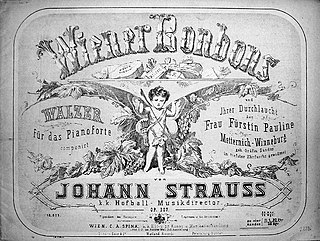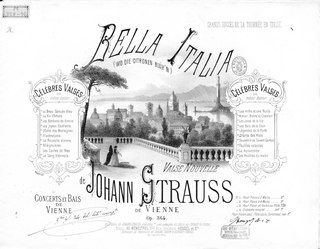Farewell to America (w/o op.) is the name of a waltz composed by Johann Strauss II. In the immediate wake of the composer's visit to the United States in the summer of 1872, when he conducted several times in Boston and New York, no less than seven publishers issued waltzes supposedly composed by Strauss. Only two from the total of nine compositions that were published are known to have been performed by Strauss during his tour of the United States: the Jubilee Waltz and the Manhattan Waltzes . It is unknown whether or not the other compositions that were published were written by Strauss while he was in America, completed by him after his return to Vienna and sent through the mail, or that some of the publications had nothing to do with Strauss himself, but were compiled by publishers anxious to benefit from Strauss' American tour and the clamour for new Strauss music. [1]
In musical composition, the opus number is the "work number" that is assigned to a composition, or to a set of compositions, to indicate the chronological order of the composer's production. Opus numbers are used to distinguish among compositions with similar titles; the word is abbreviated as "Op." for a single work, or "Opp." when referring to more than one work.

The waltz is a ballroom and folk dance, normally in

Johann Strauss II, also known as Johann Strauss Jr., the Younger, the Son, Johann Baptist Strauss, son of Johann Strauss I, was an Austrian composer of light music, particularly dance music and operettas. He composed over 500 waltzes, polkas, quadrilles, and other types of dance music, as well as several operettas and a ballet. In his lifetime, he was known as "The Waltz King", and was largely responsible for the popularity of the waltz in Vienna during the 19th century.
Unlike its companion waltz, the Greeting to America , [1] Farewell to America is a potpourri of melodies previously written by Johann Strauss, including:
Potpourri or Pot-Pourri is a kind of musical form structured as ABCDEF..., the same as medley or, sometimes, fantasia. It is often used in light, easy-going and popular types of music.
- Introduction—Introduction to Karnevalsbotschafter op. 270
- Waltz 1A — theme 1A from Wiener Punschlieder op. 131
- Waltz 1B — theme 1B from Spiralen op. 209
- Waltz 2A — theme 2B from Gedankenflug op. 215
- Waltz 2B — theme 2B from Gedankenflug op. 215
- Waltz 3A — theme 1A from Controversen op. 191
- Waltz 3B — theme 4B from Controversen op. 191
- Waltz 4A — theme 5A from Promotionen op. 221
- Waltz 4B — theme 2B from Petitionen op. 153 (composed by Josef Strauss)
- Coda — 15 bars from Coda of Feuilleton op. 293
Karnevalsbotschafter op. 270 is a waltz composed by Johann Strauss II in the autumn of 1862. Incidentally, it was also written during Strauss' honeymoon with his first wife Henrietta Treffz in Venice. It was first performed at the 50th anniversary celebration of the Vienna's Gesellschaft der Musikfreunde at the 'Sperl' dance hall on 11 November 1862 and also at a soirée there on 22 November. The title may be alluded to Strauss himself, as a 'carnival ambassador' to Venice having accomplished the year's Fasching festivity commitments in Vienna. Unsurprisingly for him in Venice, although his wife had intended the honeymoon as a complete rest for him, he found himself duly inspired to pen this lovely waltz in a period of great personal happiness.
Promotionen (Graduations), Op. 221, is the name of a waltz composed by Johann Strauss II. It was dedicated to the law students at the Vienna University, and was first performed under the title of Die Präparanden, a term referring to students who are preparing for their final examinations. The waltz was not very successful when first performed in the Sofienbad-Saal on February 8 1859: the Fremden-Blatt, although praising the execution of the waltz, said that it "lacked the rhythm and melody of older Strauss compositions." However, a reviewer for the Wiener Allgemeine Theaterzeitung was less critical of the composition, commenting that "in particular the first, third and fifth [waltz sections] are rich in fresh and attractive melodies [...] through this composition Strauss has lately demonstrated that he still has at his disposal a profusion of piquant and original melodies."

Josef Strauss was an Austrian composer.
(The waltz also has a quotation from The Star Spangled Banner. [1] )
The presence of a melody by Josef Strauss, found in Waltz 4B, suggests that Farewell to America was perhaps compiled not by Strauss himself, but by a house arranger for the publisher, Oliver Ditson. [1]





